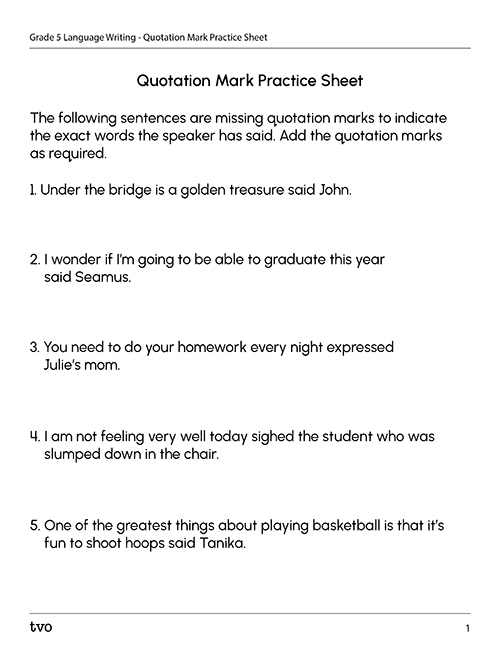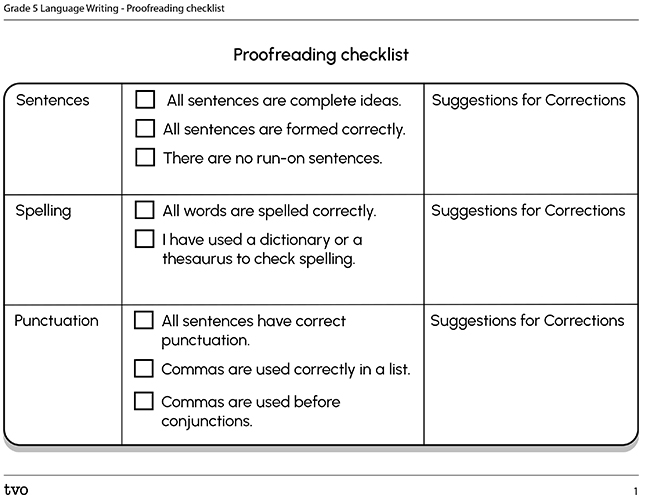Minds On
Ways to express yourself: proofreading

Proofreading is the skill of finding and correcting mistakes. Proofreading is close to the last step in the writing process, just before publishing a piece of writing. However, just because it comes last doesn’t mean it’s the least important. Proofreading is one of the most important and helpful ways to make sure that what you are creating is clearly communicated and will not lead to any misunderstandings.
Here is a piece of text that needs some proofreading. Examine the following paragraph with a partner or with the class. Can you spot the errors?
Well its another rainy day. I wonder what I will do? First, I think I’ll take a walk around the neyborhood to stretch my legs. Second I’ll cook a big breakfast with toast fruit eggs and bacon. After that, I might mow my lawn; it’s getting pretty long. I’m not sure what I’ll do after that. I guess I should go see my mother I think she wants me to go groshery shopping with her. I have no idea why she can’t just go by her self. Or, better still, she could ask my dad to go with her! I doubt he will want to go with her though. He doesn’t like going to the groshery store as much as I do!
Paragraph with Errors
What kind of mistakes did you notice in the paragraph? How do you think proofreading would help this author? What do you think would happen if this author didn’t proofread? Be ready to discuss your ideas.
Action
Why do we proofread?
Proofreading is important because it can add power to your work. Without it, your work has a higher chance of containing errors such as poor sentence structure, misspellings, tense confusion, and grammatical mistakes. These can really undermine your ability to communicate as an author. Let’s explore the individual parts that make up the skill of proofreading.

Spelling
If words are not spelled correctly, the reader can have a difficult time understanding what the writer is trying to express. Explore this video by Teacher Wynne about how to practice spelling.
Silent letters
Reference books such as dictionaries and thesauruses are excellent resources to help you with your spelling. Of course, a spell check tool on a personal device like a phone, tablet, or computer is also useful. Additionally, some students keep their own personal book of commonly used words which can help improve their spelling. Improved spelling could help a reader understand what you are trying to express.
Create a word bank of your own. Using a method of your choice, record 10 words that you use frequently but are unsure how to spell. Then, use a dictionary to check your spelling! If possible, trade lists with a partner and practice spelling those words.
Quotation marks
Quotation marks are used by writers to indicate words spoken by a character. They are also used to indicate direct quotes, with certain titles of works, and to imply alternate meanings. The easiest example of using quotation marks is when you want to use someone else’s words in your work. Let’s say you want to record something you heard your friend say. You could do it as follows:
Example: John said, “I like your dog’s new collar.”
The sentence contains a direct quote, a quote in which you report the exact words John used.
Access the following video where Teacher Charmain explains how to use quotation marks.
Did you notice how Teacher Charmain placed the exclamation mark and period inside the quotation marks?
Practice
Now it’s your turn to practice.
The following sentences are missing quotation marks to indicate the exact words the speaker has said and punctuation. Identify where quotation marks belong in these sentences, as well as any missing punctuation. If you need some help, try looking in a novel you are reading to see how the dialogue is written. You may print out these sentences, or use another method that works for you.
Quotation Mark Practice Sheet
The following sentences are missing quotation marks to indicate the exact words the speaker has said. Add the quotation marks as required.
- Under the bridge is a golden treasure said John.
- I wonder if I’m going to be able to graduate this year said Seamus.
- You need to do your homework every night expressed Julie’s mom.
- I am not feeling very well today sighed the student who was slumped down in the chair.
- One of the greatest things about playing basketball is that it’s fun to shoot hoops said Tanika.
- Someone on the television said yesterday you should be prepared for a possible storm tomorrow.
Complete the Quotation Mark Practice Sheet in your notebook or use the following fillable and printable document to help you get started.
Sentence structure
Properly formed sentences are important because they provide us with the framework for the clear expression of our ideas. The aim when writing is always to record in complete sentences which are correctly punctuated. Sentences always begin with a capital letter and end in either a full stop, exclamation or question mark.
A complete sentence always contains a verb, expresses a complete idea and makes sense standing alone.
Explore the following video where Teacher Wynne explains how run-on sentences can affect how a reader understands the text.
Proofreading for sentence fragments is also important when rereading your work. Every sentence must have a subject (object or noun) and a predicate (an action that the subject is doing).
Explore the following sentences and decide if they are full sentences, run-on sentences, or sentence fragments. When you’re finished, compare your work with a friend’s. Did you get the same answers?
- Rabbits hop.
- The big brown fluffy rabbit in the garden.
- Rabbits love to eat carrots and one hopped into our garden and I thought it was cute even though it was eating the carrots.
- The hungry rabbit hopped into the garden because he wanted to eat a carrot.

Proofread the following paragraph in you notebook for sentence structure and insert the correct punctuation. Be sure to capitalize words where necessary. When you’re finished, compare your work with a friend.
I have a dog he is a Labrador he is black in color he wags his tail and licks my face when he is
happy he loves going for walks and chasing a red ball I take him to school sometimes once he
saw a black cat and wanted to chase her too but I didn’t let him he is mad at me I don’t know but
I sure hope he isn’t I love my dog very much because he always obeys me and follows me
everywhere.
Lastly, we will look at how commas are used and their importance when proofreading. Here are just a few of the rules that you need to be familiar with when using commas.
Commas can be used as follows:
Example:
I like to eat cookies, cake, ice cream, and brownies.
Example:
I like to eat cookies, and I like to eat cake.
Example:
After thinking about it, I decided to eat the last cookie.
Example:
“I like to eat cookies,” I said.
I said, “I like to eat cookies.”
Example:
Dear Mom,
I love your homemade cookies.
Love, Sally
Explore the following two videos to learn how to use commas in a list and after a person’s name in a sentence or greeting.
Practice
Let’s practice using commas before conjunctions in compound sentences. Use the following conjunctions to join two sentences into one: For, And, Nor, But, Or, Yet, and So. Don’t forget the commas!!

You may print out these sentences, discuss your ideas out loud with a friend, or use some other method that works for you.
Example: I don’t want to argue with you. I don’t want to give in.
Answer: I don’t want to argue with you, and I don’t want to give in.
Comma Practice Sheet
Use the following conjunctions to join two sentences into one: For, And, Nor, But, Or, Yet, and So. Don’t forget the commas!!
- She had a lot of friends. She was a friendly girl.
- I had a cute puppy. I lost him.
- Seamus studied for the test. He got a good grade.
- Katie can boil eggs. She can make toast.
- Jill runs a mile every day. She swims on Fridays.
Complete the Comma Practice Sheet in your notebook or use the following fillable and printable document to help you get started.
Consolidation
Creating your paragraph
As you have learned, proofreading involves searching for many grammatical and spelling errors. At this point it’s important to practice proofreading on your own work.

Create a paragraph about something that means a lot to you. Perhaps you care about the environment or you might choose to construct an opinion about your favourite sport, book, or music. Try to use some words that are challenging for you to spell. You may use paper, a computer, or an audio recorder for this task. When you are done, proofread your work.
Complete the Proofreading Checklist in your notebook or use the following fillable and printable document to help you get started.
|
Sentences |
Suggestions for corrections | |
|
Spelling |
Suggestions for corrections | |
|
Punctuation |
Suggestions for corrections |
Once you have proofread your work, if possible, trade paragraphs with a partner and review each other’s work. Did you catch any new mistakes? Did you learn any new words that you could add to your word bank? Reflect with each other what was easy and difficult about proofreading. Be prepared to share your ideas.
Reflection
As you read through these descriptions, which sentence best describes how you are feeling about your understanding of this learning activity? Press the button that is beside this sentence.
I feel...
Now, record your ideas using a voice recorder, speech-to-text, or writing tool.
Press ‘Discover More’ to extend your skills.
Discover MoreCreate a text message or email to your friend using social media language (2day = today, U = you, etc.). Show a friend and ask if they can figure out what you are trying to say. Have your friend recreate the message into a complete paragraph using proofreading strategies. You may choose to use the proofreading checklist to help you.


